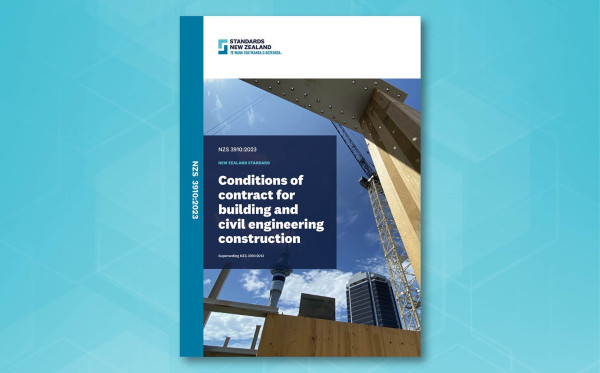Collaboration and clarity with NZS 3910 underpinning construction contracts
Our building, construction, engineering and infrastructure industries rely on NZS 3910 Conditions of contract for building and civil engineering construction to ensure that contracts are suited to New Zealand’s industrial and legislative scene. A 2023 revision brings good practice up to date.

The building and construction industry is worth $18 billion to New Zealand’s economy, equating to a third of New Zealand’s workforce and constituting 12% of all businesses. So, contracts that underpin this massive volume of work, and set clear understanding for deliverables and responsibilities, need to be comprehensive but at the same time easy to understand.
With origins stretching back nearly 60 years, the 2023 revision of NZS 3910 is the first substantial revision in a decade, jointly commissioned by the Construction Sector Accord (through Ministry of Business, Innovation and Employment Hīkina Whakatutuki) and the New Zealand Infrastructure Commission, Te Waihanga. David Wilkie was Chair of the development committee and brings substantial experience as a Director of TSA Management. Having worked on major New Zealand construction projects over 3 decades, including SkyCity New Zealand International Convention Centre (NZICC), the Auckland Metropolitan Rail Network improvements, the Auckland City Hospital, and Auckland War Memorial Museum, he understands the complexities of construction contracts. David talks us through what people can expect in this revision.
‘NZS 3910 is very well used and accounts for nearly 80% of construction contracts written in New Zealand. It’s designed to be suitable for “most contracts, most of the time”. While it’s generally well understood by the sector, over the last ten years the contracting environment has changed. This has led to a large number of special conditions being introduced, which often has resulted in an imbalance in risk allocation. Industry representatives told us that there were so many amendments and variations that a wholesale review and update was warranted.
‘The committee were given good direction over what the industry was concerned about and have addressed those and more! There are 23 people on the committee, ranging from contractors to designers, principals, private and central and local government professionals. Our approach reflected the diversity of our skills and experience.
‘The outcome also integrates feedback from the 2,274 public consultation comments. Many comments were several hundred words in length, and we identified a series of common threads. This was a massive task for the committee and highlights the level of interest in this standard.'
What’s new in this revision?
‘People will be keen to know what’s new, and be asking “how will this help me?” Firstly, the new standard remains familiar in content and structure. Of note is the:
- introduction of an order of precedence in the Contract Agreement;
- introduction of a Target Cost Contract Price, and provisions for the Contract Price to have various components including Lump Sum, Cost Reimbursable, Measure and Value, and Target Price.
- inclusion of a new clause dedicated to the Protection of the Environment.
- addition of clear contract administration processes throughout, including new content on reviewing instructions and decisions.
- elimination of the Engineer to the Contract and its dual role, replacing it with two distinct new roles. This significant change ensures clarity on the purpose of each role, emphasising when specific activities demand fairness and impartiality.
- transition to fault-based indemnity and the introduction of a Limitation on Liability.
- introduction of the Final Account and Interim Final Account processes.
- inclusion of important prompts to clearly identify Contractor’s Design Obligations.
‘The industry wanted more collaboration, and we’ve woven principles and requirements throughout the document. While we could not cater for every request, NZS 3910 is fair.'
Built on collaboration
'The committee have given their time and experience generously (largely pro-bono) and the new standard is an exemplar of industry collaboration. Differences of opinion were sensitively and sensibly discussed, and the committee’s flexible approach resulted in no stalemates and unanimous endorsement. It has truly been a team effort, and I want to thank the committee and public for contributing their knowledge and expertise so generously.
‘NZS 3910:2023 gives a clearer overview of key clauses, retains valuable examples and flow charts, and eliminates any confusing or redundant content. The language is straightforward, consistent, and gender neutral, and legislative references remain timeless.
‘I’m proud of the work done we have done and feel we’ve landed on a very good standard that reflects modern industry practice and provides clear risk allocation.
‘No matter the size of your construction project, I strongly encourage you to immediately adopt and use the industry-agreed best practice contract NZS 3910:2023.’
NZS 3910 Conditions of contract for building and civil engineering construction is available via the link at the top of this article.
